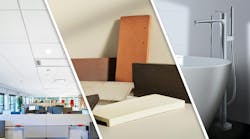Using Wood for Sustainable Design + Construction
Using Wood for Sustainable Design + Construction
Wood is a historic, classic, and durable building material that has leant longevity, aesthetics, and a natural flair to buildings for thousands of years. And while wood has long been considered an environmentally friendly resource, more and more focus is being placed on the recycling and renewability aspects of wood products, as
| LEARNING OBJECTIVES After reading this article, you should be able to: > Describe the attributes of wood materials that apply to green building. > Discuss sustainable design considerations for the application of wood to building structure, envelope, and interior finishes. > Compare the environmental merits of wood and alternative material choices. |
well as the use of certified forest land.
More than 200 million acres of forestland in the U.S. alone are certified as sustainable and responsibly managed, attributable to four main forest certification programs active in North America:
• The Forest Stewardship Council— an international organization which requires chain-of-custody documentation and product labeling. The FSC sanctions the work of third-party certifiers, such as the Rainforest Alliance’s SmartWood program and Scientific Certification System’s Green Cross label.
• The Sustainable Forestry Initiative (SFI)—a certification program developed by the American Forest and Paper Association.
• The American Tree Farm System—a certification program primarily targeted at small, non-industrial forest landowners.
• The Sustainable Forest Management Program—a certification program developed by the Canadian Standard Association (CSA).
Validating assurance of legality and sustainability for the

